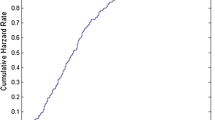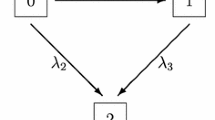Abstract
One important goal in multi-state modeling is the estimation of transition probabilities. In longitudinal medical studies these quantities are particularly of interest since they allow for long-term predictions of the process. In recent years significant contributions have been made regarding this topic. However, most of the approaches assume independent censoring and do not account for the influence of covariates. The goal of the paper is to introduce feasible estimation methods for the transition probabilities in an illness-death model conditionally on current or past covariate measures. All approaches are evaluated through a simulation study, leading to a comparison of two different estimators. The proposed methods are illustrated using a real colon cancer data set.








Similar content being viewed by others
References
Aalen O, Johansen S (1978) An empirical transition matrix for non homogeneous markov and chains based on censored observations. Scand J Stat 5:141–150
Akritas M (1994) Nearest neighbor estimation of a bivariate distribution under random censoring. Ann Stat 22:1299–1327
Altman N, Leger C (1995) Bandwidth selection for kernel distribution function estimation. J Stat Plan Inference 46:195–214
Amorim A, de Uña-Álvarez J, Meira-Machado L (2011) Presmoothing the transition probabilities in the illness-death model. Stat Probab Lett 81(7):797–806
Andersen P, Borgan Ø, Gill R, Keiding N (1993) Statistical models based on counting processes. Springer, New York
Arjas E, Eerola M (1993) On predictive causality in longitudinal studies. J Stat Plan Inference 34:361–384
Beran R (1981) Nonparametric regression with randomly censored survival data. Technical report. University of California, Berkeley
Breslow NE (1972) Discussion of the paper by D. R. Cox. J R Stat Soc Ser B 34:216–217
Cox DR (1972) Regression model and life-tables. J R Stat Soc Ser B 34(2):187–220
Dabrowska D (1987) Non-parametric regression with censored survival data. Scand J Stat 14:181–197
Dabrowska D, Ho W (2000) Confidence bands for comparison of transition probabilities in a markov chain model. Lifetime Data Anal 6(1):5–21
Dabrowska D, Lee W (1996) Nonparametric estimation of transition probabilities in a two-stage duration model. J Nonparametr Stat 7:75–103
Kaplan E, Meier P (1958) Nonparametric estimation from incomplete observations. J Am Stat Assoc 53:457–481
Kyung-Joon C, Schucany W (1998) Nonparametric kernel regression estimation near endpoints. J Stat Plan Inference 66:289–304
Lin D, Sun W, Ying Z (1999) Nonparametric estimation of the gap time distributions for serial events with censored data. Biometrika 86:59–70
Meira-Machado L, Roca-Pardiñas J (2011) p3state.msm: analyzing survival data from an illness-death model. J Stat Softw 38:1–18
Meira-Machado L, de Uña-Álvarez J, Cadarso-Suárez C (2006) Nonparametric estimation of transition probabilities in a non-markov illness-death model. Lifetime Data Anal 12:325–344
Meira-Machado L, deUña-Álvarez J, Cadarso-Suárez C, Andersen P (2009) Multi-state models for the analysis of time to event data. Stat Methods Med Res 18:195–222
Moertel C, Fleming T, McDonald ea JS (1990) Levamisole and fluorouracil for adjuvant therapy of resected colon carcinoma. N Engl J Med 322:352–358
Mostajabi F, Datta S (2013) Nonparametric regression of state occupation, entry, exit and waiting times with multistate right censored data. Stat Med 32:3006–3019
Nadaraya E (1965) On nonparametric estimates of density functions and regression curves. Theory Appl Probab 10:186–190
Satten G, Datta S (2001) The Kaplan–Meier estimator as an inverse-probability-of-censoring weighted average. Am Stat 55(3):207–210
Strzalkowska-Kominiak E, Cao R (2013) Maximum likelihood estimation for conditional distribution single-index models under censoring. J Multivar Anal 114:74–96
Strzalkowska-Kominiak E, Cao R (2014) Beran-based approach for single-index models under censoring. Comput Stat 29(5):1243–1261
Van Keilegom I (2004) A note on the nonparametric estimation of the bivariate distribution under dependent censoring. J Nonparametr Stat 16:659–670
Van Keilegom I, Akritas M, Veraverbeke N (2001) Estimation of the conditional distribution in regression with censored data: a comparative study. Comput Stat Data Anal 35:487–500
Wand M, Jones M (1997) Kernel smoothing. Chapman & Hall, London
Watson G (1964) Smooth regression analysis. Sankhya 26(15):175–184
Acknowledgments
This research was financed by FEDER Funds through Programa Operacional Factores de Competitividade COMPETE and by Portuguese Funds through FCT—Fundação para a Ciência e a Tecnologia, within Projects PEst-OE/MAT/UI0013/2014 and PTDC/MAT/104879/2008. We also acknowledge financial support from the project Grants MTM2008-03129 and MTM2011-23204 (FEDER support included) of the Spanish Ministerio de Ciencia e Innovación and 10PXIB300068PR of the Xunta de Galicia. Partial support from a grant from the US National Security Agency (H98230-11-1-0168) is greatly appreciated. We thank the reviewers and the AE for their constructive comments.
Author information
Authors and Affiliations
Corresponding author
Appendix: Additional simulation results
Appendix: Additional simulation results
In this section we give the additional simulation results for the two estimators (IPCW and LIN-based) using local linear weights instead of NW weights. The results were obtained using the dpik function which is available from the R KernSmooth package. See Tables 4, 5 and 6 below. Results for independent censoring were also obtained (not shown), leading to similar conclusions to those shown in Sect. 3 and in this Appendix.
Rights and permissions
About this article
Cite this article
Meira-Machado, L., de Uña-Álvarez, J. & Datta, S. Nonparametric estimation of conditional transition probabilities in a non-Markov illness-death model. Comput Stat 30, 377–397 (2015). https://doi.org/10.1007/s00180-014-0538-6
Received:
Accepted:
Published:
Issue Date:
DOI: https://doi.org/10.1007/s00180-014-0538-6




